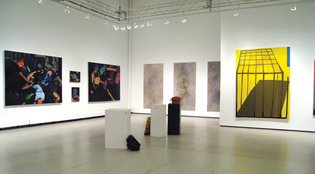 loading
loading
Light & VerityStudent's art project sparks outrage Mark Zurolo ’01MFAThe senior art exhibition in Green Hall opened without Aliza Shvarts's controversial project. View full imageOn April 17, the Yale Daily News reported that for a senior art project, Aliza Shvarts ’08 had artificially inseminated herself "as often as possible" for nine months and repeatedly taken a substance to induce miscarriage. She then videotaped those alleged miscarriages for an installation that was also to incorporate blood from the miscarriages. The installation was to be part of an end-of-the-year exhibit of work by senior art majors. "I hope it inspires some sort of discourse," Shvarts told the News. There was no shortage of discourse. The project was widely condemned on campus, with students from both pro-life and pro-choice groups expressing their disapproval. That sense of outrage was echoed in dozens of media outlets, including the Washington Post and Fox News. Six minutes after the Drudge Report picked up the story, with the headline "SHOCK," the News's website crashed from too many hits. With feelings running so high, the relief was nearly palpable later in the day when Yale spokeswoman Helaine Klasky released a statement that the project was a "creative fiction designed to draw attention to the ambiguity surrounding the form and function of a woman's body." Klasky reported that Shvarts had told three senior Yale officials that she had neither impregnated herself nor induced miscarriages. The student contradicted Klasky the next day, however, in a guest column in the News. In it, Shvarts elaborated on her nine-month "project": relying on anonymous sperm donors, she had regularly inseminated herself from the 9th to 15th days of her menstrual cycle, and she had subsequently ingested an abortifacient on the 28th day of her cycle. She never knew for certain whether she was pregnant, she explained, because the "miscarriages" were timed to coincide with her expected date of menstruation. "An intentional ambiguity pervades both the act and the objects I produced in relation to it," Shvarts wrote. To support her claims, Shvarts previewed, for the News, video footage that showed her in a shower stall, bleeding into a cup. Shvarts, a resident of Davenport College, told the student reporters that her project had the backing of the Davenport dean and two School of Art faculty members. The School of Art and the dean of Davenport referred requests for comment to Yale's Office of Public Affairs, which maintained that Shvarts's denial was "part of her performance." But the dean of the School of Art, Robert Storr, seemed to treat the performance as real, writing in a statement that the project was unacceptable "in a community where the consequences go beyond the individual who initiates the project and may even endanger that individual." Yale College dean Peter Salovey ’86PhD, for his part, said the project as reported in the media bore "no relation to what I consider appropriate for an undergraduate senior project." He also said that he and Storr had determined that Shvarts's senior project adviser and another unidentified adviser had made serious errors of judgment. A day before the senior exhibit was to open, Salovey announced that he would prohibit Shvarts's work from being included unless "she submits a clear and unambiguous statement that her installation is a work of fiction" and that the installation contains no human blood. University secretary and vice president Linda Lorimer ’77JD explains that "the university would not countenance any kind of public art that involves physical blood -- as a health issue." Lorimer also said there will be a "thorough review" of the processes for undergraduate art projects. In the end, Shvarts did not agree to the dean's conditions, choosing instead to submit —but not publicly display—another piece as her senior project. The senior art exhibit went on without her controversial project, but her performance could not be so readily erased.
The comment period has expired.
|
|